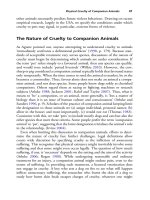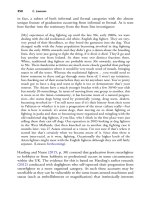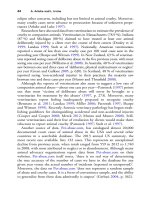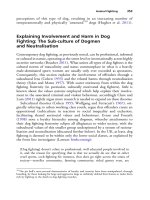The palgrave international handbook of a 177
Bạn đang xem bản rút gọn của tài liệu. Xem và tải ngay bản đầy đủ của tài liệu tại đây (37.45 KB, 1 trang )
Breeding and Rearing Farmed Animals
169
human and non-human animals are exploited under capitalism, the forms of
exploitation differ. The bodies of non-human animals are not only are
exploited by working for us in order to produce animal food products, their
bodies are themselves ‘superexploited living commodities’ (2007, p. 58).
Animal lives and bodies are a means to profit creation within capitalism. In
addition, animals are property, and this means that, in the case of animal
agriculture, animals are ‘sensate living machines’ for the production of commodities (2007, p. 64). For Torres, as for Nibert, capitalism remains the key
explanatory framework, and the analysis of human relations with non-human
domesticate animals is conceptually underpinned by notions of property
relations and commoditisation.
More recently, Nibert has made the case that the process of domestication is violent and abusive in and of itself. It involves the enslavement of
species via their ‘domesecration’ (2013, pp. 24–30). Comparing practices of
animal exploitation for food and resources in different societies over time,
Nibert focuses on nomadic pastoralism and the development of commercial
ranching, a practice that has been largely controlled by elite groups and
expanded with the rise of capitalism. Beginning with the pastoral societies
of the Eurasian steppe and continuing through to the contemporary exportation of Western, meat-centred eating habits, Nibert connects the domesecration of animals to the interests of powerful social elites and to mass
violence, invasion, displacement and enslavement. Conquest and subjugation were the results of the need to appropriate land and water to maintain
large groups of animals, and the amassing of military power has its roots in
the economic benefits of the exploitation, exchange, and sale of animals.
Nibert argues that the domesecration of animals was a precondition for the
oppression of human populations, particularly indigenous peoples (2013,
p. 4). Historically, the material interests of social, political and economic
elites are inextricably linked to the exploitation of animals and this has been
spread and deepened with the development of capitalism.
For other critics of industrial animal agriculture such as Jocelyne Porcher
(2014), however, the history of domestication is not one of violence but of
co-operation and shared working between human communities and the
animal species they lived and worked alongside. Nibert would argue that
relations with domesticates involved exploitation and abuse from the start,
and might never by anything else. Porcher suggests, however, drawing on
her experience as a small-scale farmer and her research on different farming
practices and systems, that the problem is what industrial large-scale production for the profit motive has made of the breeding and rearing of
farmed animals, rather than the processes of domestication itself. Our lives









